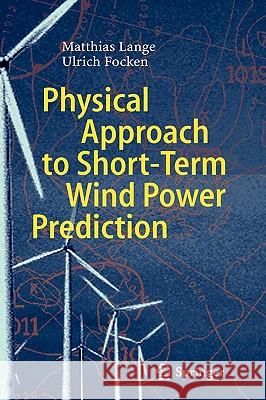Physical Approach to Short-Term Wind Power Prediction » książka
Physical Approach to Short-Term Wind Power Prediction
ISBN-13: 9783540256625 / Angielski / Twarda / 2005 / 208 str.
Physical Approach to Short-Term Wind Power Prediction
ISBN-13: 9783540256625 / Angielski / Twarda / 2005 / 208 str.
(netto: 559,69 VAT: 5%)
Najniższa cena z 30 dni: 578,30 zł
ok. 20 dni roboczych.
Darmowa dostawa!
Triggered by a discussion on the nature of future electricity supplies, wind - ergy utilisation has boomed dramatically, ?rst in the United States of America and Denmark and later in Germany and Spain. Thanks to state subsidies, it has within 15 years overtaken the volume of the classic renewable hydro-power, and today it accountsforabout5%ofelectricitygeneration. Twofactorssetoffthisdevelopment: anawarenessofthelimitedavailabilityof fossilfuelsandtherecognitionthatinthe19thand20thcenturiesthemassiverelease of fossil CO had kicked off a gigantic climate experiment whose results remain 2 unpredictable. The discussion on the side effects of the wind energy boom, such asoccupationoflandandthechallengespresentedbyintegrationintoconventional electricity generation systems, frequently distract attention from the real goals and bene?ts of this technology. These are establishing an energy sector that will, in the shortterm, reduceCO emissionsandtheexploitationof?niteresourcesand, inthe 2 longterm, createanunlimitedsustainableenergysupply. Because fossil reserves are relatively easy to exploit, a system developed that could hardly be more convenient. It makes electric power available in large quan- tiesatmoderatepricesandinawaythatiseasytoplan.Thetaskofthepowerutility is essentially limited to uncritically adjusting the supply from central power s- tionstothedemandfromconsumers.Alow-CO sustainableenergysectordemands 2 differentstandards.Windandsolarpowerhaveahighpotential, buttheyaresubject tohighnatural?uctuationsand, ingeneral, areconnectedtotheelectricitygridina decentralway.Theshareoffuturestoragetechnologiessuchashydrogentechnology willbeassmallaspossibleforreasonsofef?ciencyandcost. So, future-compatibleelectricitygenerationwillcomprisemanydifferent, partly innovative components, which also demands a considerable research and devel- menteffort.Ontheonehand, thereisthe?uctuatinginputfromrenewablesources, and on the other, electricity consumption that must to a certain extent be adjusted to supply by means of intelligent solutions. In between, to a declining extent, VI Foreword modernconventionalenergyproducers, suchascoalandnaturalgaspowerstations, areallbroughttogetherwithagreatdealoftechnicalingenuityintheformofcontrol strategiesandinformation?











